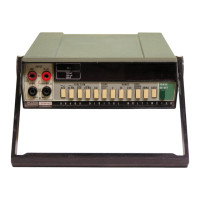8600A
controls the loop
and consequently the bias on
Ul. The
current output from
Ul changes for each range
(refer to
table
3-1)
but is constant
within each range. Figure
3-3
is
a
simplified circuit
diagram.
3-27.
With Rx
=
0
(VC2 HI shorted to
VT2 LO) there
is
OV at the
noninverting
input
of
Ul . U3 has a negative
reference voltage
applied
to
its
noninverting
input and
a
greater negative
voltage applied to
its inverting
input. This
produces a positive
output from U3
and
allows
Q3
to con-
duct.
Q3
conducts
an amount of current such
that the
voltage drop
on R35 equalizes
the input voltages
on Pins 2
and 3 of U3. The
amount of current required
by
Q3
is
constant in all operating
conditions.
As
Q3
is turned on,
a negative voltage is
applied to the inverting
input of Ul
.
The
negative input
causes the output
of Ul to go positive
until
the current through
R20 and
R90
satisfies
the current
requirement of
Q3.
The voltages
at that point are
+10V
out of
Ul
,
and OV at
the inverting input of
U
1 ,
matching
the
OV at the noninverting
input
of Ul. The 10V out of
Ul
is dropped across
the input divider network.
Ten volts
is maintained across
the input divider
in
all ranges
except
the 20 range. Relay
K5
energizes in the
20 Mf2 range
to
change the
feedback
loop (R20 and R90)
by a factor
of
ten
with R22 and
R41
. The output of Ul changes from
1 OV to
1
V
and only
1
V is dropped
by
the input divider.
The value of
lx is dependent
on the
range relays.
3-28
As Rx increases from
0,
Vx
(at the
Vf2
HI terminal)
also increases from
OV proportional
to the value
of
Rx. Vx
appears
at the noninverting
input of
Ul and at the input to
the A/D Converter.
Ul is turned
on more
and the output
voltage
increases until the voltage
at
the
inverting
input of
Ul equals
Vx at
the
noninverting
input. The output voltage
of Ul equals 10V
+
Vx.
Since the
current drawn
by
U3
and
Q3
is constant, 10V
is always dropped
by R20 and R90
(except
in the 20
MS2
range)
and the voltages at the output
of Ul and the inverting
input of
Ul track any changes in
Vx (and
Rx)
at the
inverting input
of Ul
.
So within
each
range the
current
is constant and
the voltage,
Vx,
at the
Vf2 terminals
is proportional
to Rx.
3-29
If
the voltage
at
the input
terminals is too
small
or
exceeds
2V, autoranging
is initiated
in the DVM IC (U8).
The
voltage, (Vx)
is
held
below
a maximum of 5V.
As Vx
increases
toward 5V,
Q13
and
Q1
2 begin to conduct,
holding the voltage at the inverting
input of Ul
below 5V.
Q1
1
serves
as a
current
sink and
holds the noninverting
input of
Ul below 5V.
3-4
1/77

